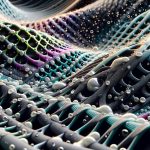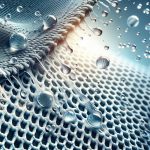You've probably noticed how some fabrics manage to keep you dry and comfortable, even during intense activities. This isn't just luck; it's the result of cutting-edge innovations in fabric moisture management. From advanced wicking technologies to smart textiles with embedded sensors, these developments are transforming the performance and sustainability of our clothing. But how exactly do these innovations work together to enhance your comfort and efficiency? And what role does eco-friendly technology play in this evolving landscape? Let's explore these questions and more, shedding light on the intricate world of moisture control in fabrics.
Table of Contents
Key Takeaways
- Moisture-Wicking Treatments: Hydrophobic layers efficiently transport sweat away from the skin, maintaining dryness.
- Advanced Knitting Techniques: Enhance moisture dispersion and evaporation through increased fabric surface area.
- Breathable Fabric Technologies: Optimize airflow and moisture mapping for quick sweat evaporation without compromising fabric strength.
- Smart Textiles: Embedded sensors monitor and adjust fabric properties in real-time for optimal moisture control.
- Eco-Friendly Solutions: Sustainable materials and biodegradable coatings achieve effective moisture management with reduced environmental impact.
Advanced Wicking Technologies
Advanced wicking technologies transform the way fabrics handle moisture, keeping you dry and comfortable.
When you grasp the intricacies behind these technologies, you can appreciate how moisture absorbing fibers and advanced knitting techniques collaborate to enhance your experience.
These fibers are crafted to actively draw moisture away from your skin, guaranteeing you stay dry even during intense physical activities.
The advanced knitting techniques utilized create a fabric structure that maximizes the surface area for moisture to disperse and evaporate rapidly.
To further enhance the fabric's performance, moisture wicking treatments are applied.
These treatments establish a hydrophobic layer on the fabric surface, enabling sweat to be transported more efficiently.
Pairing these treatments with innovative dyeing methods guarantees that the fabric maintains its moisture-wicking properties over time, even after multiple washes.
The outcome is a high-performance textile that not only handles moisture effectively but also preserves its aesthetic appeal and durability.
Breathable Fabric Structures
In the world of fabric technology, breathable fabric structures ensure ideal airflow, keeping you cool and comfortable. When designing these fabrics, engineers focus on fabric ventilation and moisture mapping to guarantee that sweat evaporates quickly. This balance is essential, particularly in high-performance sportswear or outdoor gear where comfort and dryness are paramount.
You'll find that airflow optimization is a key element in enhancing fabric breathability. Designers use various techniques, such as incorporating micro-vents or specialized weaves, to promote air circulation without compromising the fabric's strength. This means you stay cooler for longer periods, as trapped heat and moisture can easily escape.
Fabric ventilation doesn't just stop at design; it extends to material selection. High-tech fibers, like polyester blends or advanced nylons, are often utilized for their natural ability to wick moisture and allow air to flow freely. By strategically placing these materials in areas prone to heavy sweating, manufacturers achieve superior moisture management.
Moisture mapping further refines this process. By analyzing how moisture accumulates and disperses across different zones of the fabric, experts can tailor each section to maximize breathability.
Smart Textiles and Sensors
Imagine fabric that not only wicks away moisture but also tracks it in real-time.
With embedded moisture sensors, you can monitor your clothing's performance and adapt your activity accordingly.
These smart textiles offer advanced, adaptive technologies that revolutionize how you stay dry and comfortable.
Embedded Moisture Sensors
Embedded moisture sensors in smart textiles offer real-time monitoring of fabric moisture levels, enhancing both comfort and performance. By integrating advanced wearable technology, these sensors guarantee that your clothing can adapt to changing conditions, maintaining peak fabric performance.
You'll find that sensor integration within the fabric is seamless, making the garments indistinguishable from traditional clothing in terms of comfort and appearance.
These sensors excel in moisture detection, providing immediate feedback on sweat levels or external moisture exposure. This capability is particularly useful in athletic wear, where maintaining dryness can greatly impact your performance and endurance. Imagine running a marathon and instantly knowing when your clothing needs adjustment to keep you dry and comfortable.
Moreover, the precision of these embedded moisture sensors allows you to monitor even the slightest changes in fabric humidity. This meticulous attention to detail means you can rely on your smart textiles to perform under various conditions, from intense workouts to everyday wear.
In short, the integration of moisture sensors elevates your experience, making sure that your clothing works as hard as you do.
Real-Time Data Monitoring
With real-time data monitoring, smart textiles and sensors guarantee you're always aware of your fabric's moisture levels, allowing for immediate adjustments to maximize comfort and performance. Wearable sensors embedded in your clothing continuously track moisture, providing you with instant feedback.
Imagine running a marathon and knowing exactly when your shirt starts retaining too much sweat, prompting you to take action before it affects your performance. These advanced fabrics use moisture tracking to transform your experience. They're not just reactive; they're proactive.
By understanding your body's responses, you can make timely decisions, whether you're engaging in high-intensity sports or simply going about your daily routine.
Consider the following benefits:
- Enhanced Comfort: Stay dry and comfortable by monitoring and adjusting to moisture levels in real-time.
- Improved Performance: Optimize your physical activities by keeping track of your body's needs.
- Health Monitoring: Detect unusual sweat patterns that could indicate health issues.
- Energy Efficiency: Reduce the need for excessive washing, saving water and energy.
- Customized Alerts: Receive notifications tailored to your specific moisture thresholds.
Adaptive Fabric Technologies
Smart textiles and sensors take fabric moisture management a step further by adapting to changing conditions to keep you dry and comfortable. Imagine a fabric that not only wicks away sweat but also adjusts its properties based on your activity level and environment. That's the power of textile innovations in moisture regulation. These adaptive fabrics use embedded sensors to monitor your body temperature and perspiration, making real-time adjustments to enhance your performance.
With advancements in fabric technology, these smart textiles are revolutionizing athletic wear, work uniforms, and everyday clothing. For example, they can increase ventilation during high-intensity workouts or provide extra insulation in cooler conditions. This level of customization ensures you stay at your peak, no matter the circumstance.
Here's how adaptive fabric technologies can impact you:
| Feature | Benefit | Feeling |
|---|---|---|
| Real-Time Adjustment | Peak Comfort | Empowered |
| Enhanced Ventilation | Enhanced Performance | Invigorated |
| Temperature Regulation | Year-Round Usability | Confident |
You're not just wearing fabric; you're wearing an intelligent system designed to respond to your needs. Embrace this cutting-edge technology, and elevate your experience with performance enhancement like never before.
Eco-Friendly Moisture Control
You can enhance moisture control in fabrics by choosing sustainable materials that reduce environmental impact.
Explore biodegradable coating technologies that guarantee effective moisture management while being eco-friendly.
Sustainable Materials Utilization
Eco-conscious moisture control fabrics leverage sustainable materials to efficiently wick away sweat while minimizing environmental impact. By embracing the principles of the circular economy and utilizing renewable fibers, you can enjoy high-performance fabrics that are both effective and kind to our planet.
Here are some benefits and characteristics of these innovative materials:
- Circular Economy: These fabrics are designed to be part of a closed-loop system, reducing waste and promoting recycling.
- Renewable Fibers: Materials like bamboo, Tencel, and organic cotton are used, which are sustainably sourced and biodegradable.
- Energy Efficiency: The production processes for these fabrics often require less energy compared to traditional methods, reducing their carbon footprint.
- Water Conservation: Advanced techniques make sure that water usage is minimized during the manufacturing process.
- Durability: Despite being eco-friendly, these materials don't compromise on durability, guaranteeing your garments last longer and perform better.
You'll find that sustainable materials don't just help the environment; they also offer superior moisture management to keep you comfortable and dry. By opting for these innovative fabrics, you're not just upgrading your wardrobe—you're making a conscious choice to support sustainable practices and promote a healthier planet.
Biodegradable Coating Technologies
Biodegradable coating technologies, designed for eco-friendly moisture control, are revolutionizing the textile industry by offering high performance without compromising environmental integrity. You're probably aware of the growing need to reduce the environmental impact of textile production. These coatings address that concern head-on by breaking down naturally after their useful life, unlike traditional, non-degradable finishes.
You'll find that these innovative coatings offer remarkable performance benefits. They effectively wick moisture away from the skin, keeping you dry and comfortable, whether you're wearing athletic gear or everyday clothes. Plus, they maintain their effectiveness even after multiple washes, ensuring longevity and value in your garments.
By adopting biodegradable coatings, you're not just enhancing fabric performance but also supporting sustainability. These coatings reduce the reliance on harmful chemicals and synthetic materials, leading to a smaller carbon footprint. You're contributing to a cleaner environment by choosing products that don't pollute.
Incorporating biodegradable coating technologies into your fabric choices shows a commitment to both high-quality performance and environmental stewardship. It's a smart move that aligns advanced textile engineering with the pressing need for eco-friendly solutions. So, go ahead and make a choice that benefits you and the planet.
Antimicrobial Treatments
Antimicrobial treatments play a crucial role in enhancing fabric moisture management by inhibiting the growth of bacteria and fungi. By incorporating these treatments, you can greatly improve odor control and moisture-wicking capabilities, guaranteeing that the fabric remains fresh and dry. This not only enhances comfort but also prolongs the lifespan of the fabric.
To master this concept, consider the following benefits of antimicrobial treatments:
- Odor Control: Eliminates unpleasant smells caused by microbial growth.
- Moisture Wicking: Enhances the fabric's ability to transport moisture away from the body.
- Microbial Resistance: Prevents bacteria and fungi from proliferating, maintaining hygiene.
- Fabric Durability: Increases the longevity of the fabric by reducing microbial-induced wear.
- Enhanced Comfort: Keeps the fabric feeling fresh and clean, even during prolonged use.
When you integrate antimicrobial treatments into fabrics, you're not just adding a layer of protection; you're investing in the long-term performance and comfort of the material. These treatments guarantee that the fabric remains resilient and effective, making it a critical component in the quest for superior fabric moisture management.
Applications in Sportswear and Fashion
In both sportswear and fashion, moisture management technologies ensure that clothes stay comfortable and dry, even during intense activities or long wear. You'll find that top-tier sportswear brands now integrate advanced moisture-wicking fabrics to enhance performance. These fabrics draw sweat away from your skin, allowing for faster evaporation and ensuring that you stay cool and dry. This isn't just about comfort; it's about optimizing your athletic performance.
Fashion trends have also embraced moisture management. Designers incorporate these technologies into everyday wear, blending functionality with style. Imagine wearing a chic outfit that not only looks great but also keeps you dry throughout a busy day. That's the power of modern fabric innovation.
Sustainability practices are another vital aspect. Many brands are now committed to using eco-friendly materials and processes in their moisture management technologies. You're not just investing in high-performance or stylish clothes; you're also supporting a more sustainable future.
As you explore these options, consider how performance enhancements and sustainability practices are shaping the next generation of sportswear and fashion. Your choices can make a difference, merging cutting-edge technology with conscious consumerism.
Frequently Asked Questions
How Do Different Fabric Weaves Impact Moisture Management?
Did you know tightly woven fabrics can reduce moisture retention by up to 40%? The weave impacts fabric performance substantially. A denser fabric structure improves moisture management, making it ideal for high-performance athletic wear.
What Are the Most Common Materials Used for Moisture-Wicking Fabrics?
For ideal fabric technology and performance, you'll find polyester, nylon, and merino wool are the most common materials. They excel in sweat absorption and breathability, ensuring you stay dry and comfortable during intense activities.
How Does Fabric Moisture Management Affect Skin Health?
Fabric moisture management directly impacts skin health by maintaining skin hydration and comfort. Effective sweat absorption and breathability prevent irritation, reduce the risk of infections, and keep your skin feeling fresh and healthy throughout the day.
What Traditional Methods Were Used for Moisture Control in Fabrics?
You'd find traditional methods for moisture control in fabrics primarily involved using natural fibers like cotton for sweat absorption and employing ventilation techniques. Chemical treatments were also applied to enhance moisture-wicking properties and improve comfort.
How Do Washing and Care Routines Influence Moisture-Wicking Properties?
Your washing and care routines greatly impact moisture-wicking properties. Proper drying techniques preserve fabric longevity, while avoiding harsh chemical treatments helps maintain ideal moisture absorption, ensuring your fabrics stay effective and durable over time.
- How to Care for a 100% Acetate Garment: The Complete Cheat Sheet - June 24, 2025
- Rayon Acetate Velvet Explained: Properties, Care, and Uses - June 24, 2025
- A Buyer’s Guide: Where to Find Acetate Spandex Fabric for Sale - June 24, 2025







